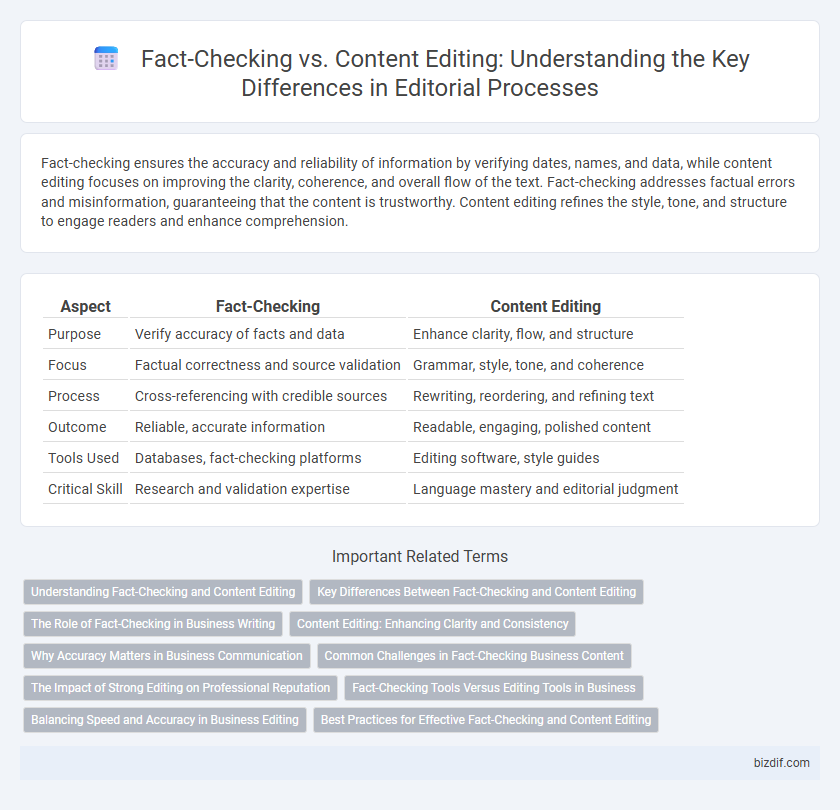Fact-checking ensures the accuracy and reliability of information by verifying dates, names, and data, while content editing focuses on improving the clarity, coherence, and overall flow of the text. Fact-checking addresses factual errors and misinformation, guaranteeing that the content is trustworthy. Content editing refines the style, tone, and structure to engage readers and enhance comprehension.
Table of Comparison
| Aspect | Fact-Checking | Content Editing |
|---|---|---|
| Purpose | Verify accuracy of facts and data | Enhance clarity, flow, and structure |
| Focus | Factual correctness and source validation | Grammar, style, tone, and coherence |
| Process | Cross-referencing with credible sources | Rewriting, reordering, and refining text |
| Outcome | Reliable, accurate information | Readable, engaging, polished content |
| Tools Used | Databases, fact-checking platforms | Editing software, style guides |
| Critical Skill | Research and validation expertise | Language mastery and editorial judgment |
Understanding Fact-Checking and Content Editing
Fact-checking involves verifying the accuracy and authenticity of factual information within a text, ensuring all data, dates, names, and statistics are correct and supported by reliable sources. Content editing focuses on improving the overall structure, clarity, flow, and coherence of the writing, enhancing the readability and engagement without altering factual accuracy. Understanding the fundamental differences between fact-checking and content editing helps maintain both the integrity and quality of written work.
Key Differences Between Fact-Checking and Content Editing
Fact-checking involves verifying the accuracy of data, dates, names, and statements within a text to ensure factual correctness, while content editing focuses on enhancing clarity, flow, and structure to improve readability and engagement. Fact-checkers validate source credibility and consistency, whereas content editors address grammar, tone, and overall message coherence. The key difference lies in fact-checking's emphasis on truth verification versus content editing's goal of refining the communication quality.
The Role of Fact-Checking in Business Writing
Fact-checking in business writing ensures accuracy and credibility by verifying data, statistics, and claims before publication. This process minimizes the risk of misinformation that can damage a company's reputation and legal standing. Precise fact-checking supports clear communication and enhances trust between businesses and their stakeholders.
Content Editing: Enhancing Clarity and Consistency
Content editing focuses on enhancing clarity and consistency by refining structure, tone, and flow to ensure the message resonates with the target audience. It involves reorganizing paragraphs, improving transitions, and maintaining a uniform style to strengthen overall readability. This process goes beyond fact-checking by addressing the effectiveness of communication and emotional impact.
Why Accuracy Matters in Business Communication
Fact-checking ensures all data and claims in business communication are verified for precision, preventing misinformation and maintaining corporate credibility. Content editing refines message clarity and tone but relies on accurate facts for effective persuasion and trust-building. Accuracy in business communication reduces risks, supports informed decision-making, and strengthens stakeholder relationships.
Common Challenges in Fact-Checking Business Content
Fact-checking business content often faces challenges such as verifying complex financial data, identifying credible sources amid abundant misinformation, and ensuring real-time accuracy in rapidly changing markets. Editors must meticulously cross-reference information with authoritative databases and financial reports to maintain integrity. Balancing thorough verification with tight publishing deadlines remains a persistent obstacle in the fact-checking process.
The Impact of Strong Editing on Professional Reputation
Strong content editing enhances clarity, coherence, and engagement, directly influencing a professional's reputation for quality and reliability. Fact-checking ensures accuracy and credibility, reinforcing trustworthiness and preventing misinformation that can damage professional standing. Together, thorough fact-checking and meticulous content editing elevate the overall integrity and perception of any published work.
Fact-Checking Tools Versus Editing Tools in Business
Fact-checking tools like Grammarly, FactCheck.org, and Snopes help businesses verify the accuracy and credibility of their content by detecting misinformation and validating sources. In contrast, content editing tools such as ProWritingAid, Adobe Acrobat, and Hemingway Editor focus on improving readability, grammar, style, and overall structure to enhance the quality of the text. Utilizing both fact-checking and editing tools ensures that business communications are both accurate and professionally polished, supporting brand reputation and effective messaging.
Balancing Speed and Accuracy in Business Editing
Fact-checking ensures the accuracy of data by verifying sources, dates, and statements to maintain credibility, while content editing enhances clarity, flow, and coherence. In business editing, balancing speed and accuracy involves prioritizing critical facts for verification without compromising the overall narrative quality, leveraging efficient tools and skilled editors. This synergy optimizes turnaround times and upholds professional standards essential for corporate communication.
Best Practices for Effective Fact-Checking and Content Editing
Effective fact-checking requires verifying all data points against credible sources, cross-referencing information, and maintaining meticulous records of sources to enhance content accuracy. Content editing focuses on improving clarity, coherence, and flow by refining language, structure, and style while ensuring alignment with the intended audience and purpose. Combining rigorous fact-checking with thorough content editing results in reliable, polished, and trustworthy publications.
Fact-checking vs Content Editing Infographic

 bizdif.com
bizdif.com